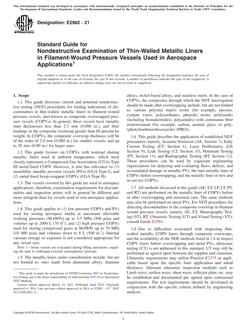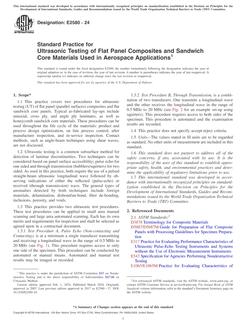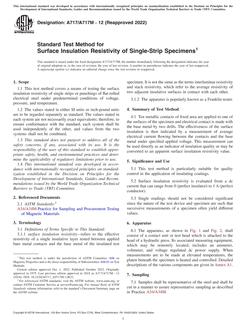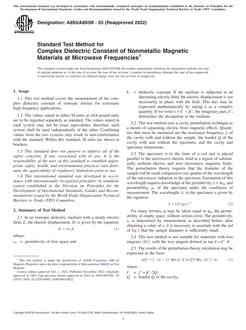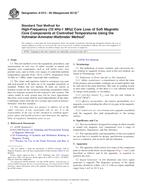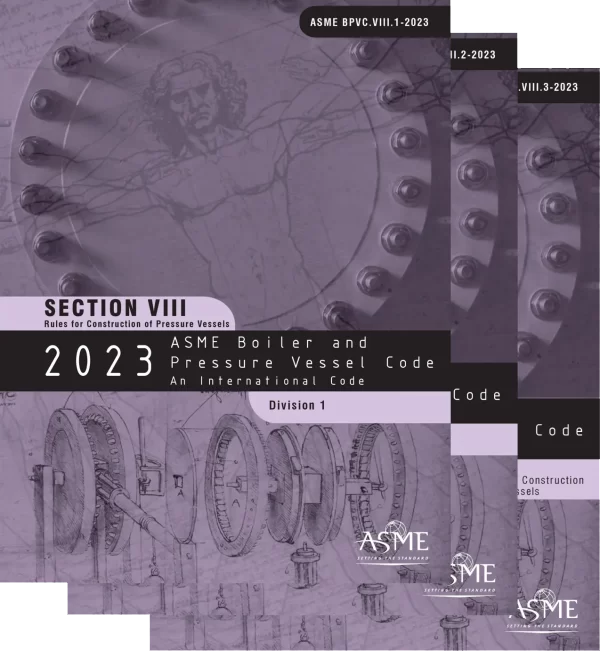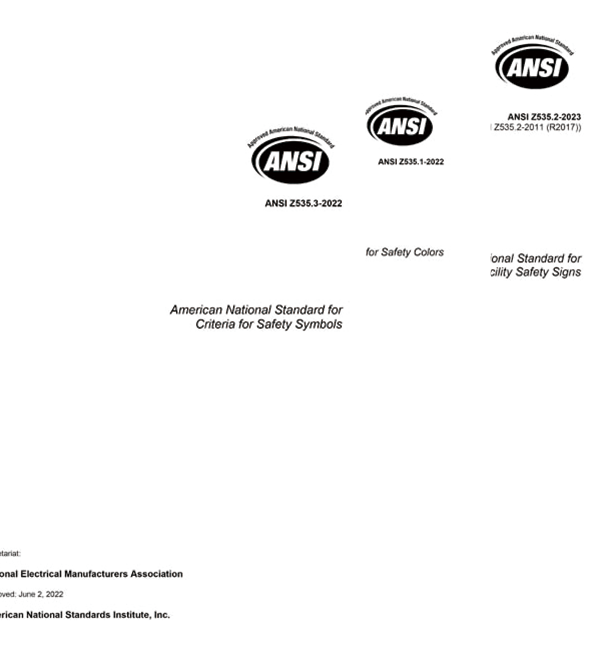ASTM E2982-21
2021
Standard Guide for Nondestructive Examination of Thin-Walled Metallic Liners in Filament-Wound Pressure Vessels Used in Aerospace Applications
- Format:
- Language(s) :
- Published :
- English
- 03/15/2021
1.1''This guide discusses current and potential nondestructive testing (NDT) procedures for finding indications of discontinuities in thin-walled metallic liners in filament-wound pressure vessels, also known as composite overwrapped pressure vessels (COPVs). In general, these vessels have metallic liner thicknesses less than 2.3 mm (0.090 in.), and fiber loadings in the composite overwrap greater than 60 percent by weight. In COPVs, the composite overwrap thickness will be of the order of 2.0 mm (0.080 in.) for smaller vessels, and up to 20 mm (0.80 in.) for larger ones.
1.2''This guide focuses on COPVs with nonload sharing metallic liners used at ambient temperature, which most closely represents a Compressed Gas Association (CGA) Type III metal-lined COPV. However, it also has relevance to (1) monolithic metallic pressure vessels (PVs) (CGA Type I), and (2) metal-lined hoop-wrapped COPVs (CGA Type II).
1.3''The vessels covered by this guide are used in aerospace applications; therefore, examination requirements for discontinuities and inspection points will in general be different and more stringent than for vessels used in non-aerospace applications.
1.4''This guide applies to (1) low pressure COPVs and PVs used for storing aerospace media at maximum allowable working pressures (MAWPs) up to 3.5 MPa (500 psia) and volumes up to 2000 L (70 ft³), and (2) high pressure COPVs used for storing compressed gases at MAWPs up to 70 MPa (10''''''000 psia) and volumes down to 8 L (500 in.³). Internal vacuum storage or exposure is not considered appropriate for any vessel size.
Note 1:''Some vessels are evacuated during filling operations, requiring the tank to withstand external (atmospheric) pressure.
1.5''The metallic liners under consideration include, but are not limited to, ones made from aluminum alloys, titanium alloys, nickel-based alloys, and stainless steels. In the case of COPVs, the composites through which the NDT interrogation should be made after overwrapping include, but are not limited to, various polymer matrix resins (for example, epoxies, cyanate esters, polyurethanes, phenolic resins, polyimides (including bismaleimides), polyamides) with continuous fiber reinforcement (for example, carbon, aramid, glass, or poly-(phenylenebenzobisoxazole) (PBO)).
1.6''This guide describes the application of established NDT procedures; namely, Acoustic Emission (AE, Section 7), Eddy Current Testing (ET, Section 8), Laser Profilometry (LP, Section 9), Leak Testing (LT, Section 10), Penetrant Testing (PT, Section 11), and Radiographic Testing (RT, Section 12). These procedures can be used by cognizant engineering organizations for detecting and evaluating flaws, defects, and accumulated damage in metallic PVs, the bare metallic liner of COPVs before overwrapping, and the metallic liner of new and in-service COPVs.
1.7''All methods discussed in this guide (AE, ET, LP, LT, PT, and RT) are performed on the metallic liner of COPVs before or after overwrapping and structural cure. The same methods may also be performed on metal PVs. For NDT procedures for detecting discontinuities in the composite overwrap in filament wound pressure vessels; namely, AE, ET, Shearography Testing (ST), RT, Ultrasonic Testing (UT) and Visual Testing (VT); consult Guide E2981.
1.8''Due to difficulties associated with inspecting thin-walled metallic COPV liners through composite overwraps, and the availability of the NDE methods listed in 1.6 to inspect COPV liners before overwrapping and metal PVs, ultrasonic testing (UT) is not addressed in this standard. UT may still be performed as agreed upon between the supplier and customer. Ultrasonic requirements may utilize Practice E2375 as applicable based upon the specific liner application and metal thickness. Alternate ultrasonic inspection methods such as Lamb wave, surface wave, shear wave, reflector plate, etc. may be established and documented per agreed upon contractual requirements. The test requirements should be developed in conjunction with the specific criteria defined by engineering analysis.
1.9''In general, AE and PT are performed on the PV or the bare metallic liner of a COPV before overwrapping (in the case of COPVs, AE is done before overwrapping to minimize interference from the composite overwrap). ET, LT, and RT are performed on the PV, bare metallic liner of a COPV before overwrapping, or on the as-manufactured COPV. LP is performed on the inner and outer surfaces of the PV, or on the inner surface of the COPV liner both before and after overwrapping. Furthermore, AE and RT are well suited for evaluating the weld integrity of welded PVs and COPV liners.
1.10''Wherever possible, the NDT procedures described should be sensitive enough to detect critical flaw sizes of the order of 1.3 mm (0.050 in.) length with a 2:1 aspect ratio.
Note 2:''Liners often fail due to improper welding resulting in initiation and growth of multiple small discontinuities of the order of 0.050 mm (0.002 in.) length. These will form a macro-flaw of 1-mm (0.040-in.) length only at higher stress levels.
1.11''For NDT procedures that detect discontinuities in the composite overwrap of filament-wound pressure vessels (namely, AE, ET, shearography, thermography, UT and visual examination), consult Guide E2981.
1.12''In the case of COPVs which are impact damage sensitive and require implementation of a damage control plan, emphasis is placed on NDT procedures that are sensitive to detecting damage in the metallic liner caused by impacts at energy levels which may or may not leave any visible indication on the COPV composite surface.
1.13''This guide does not specify accept/reject criteria (4.10) used in procurement or used as a means for approving PVs or COPVs for service. Any acceptance criteria provided herein are given mainly for purposes of refinement and further elaboration of the procedures described in the guide. Project or original equipment manufacturer (OEM) specific accept/reject criteria should be used when available and take precedence over any acceptance criteria contained in this document.
1.14''This guide references established ASTM test methods that have a foundation of experience and that yield a numerical result, and newer procedures that have yet to be validated which are better categorized as qualitative guidelines and practices. The latter are included to promote research and later elaboration in this guide as methods of the former type.
1.15''To ensure proper use of the referenced standard documents, there are recognized NDT specialists that are certified according to industry and company NDT specifications. It is recommended that an NDT specialist be a part of any thin-walled metallic component design, quality assurance, in-service maintenance, or damage examination.
1.16''Units'''The values stated in metric units are to be regarded as the standard. The English units given in parentheses are provided for information only.
1.17''This standard does not purport to address all of the safety concerns, if any, associated with its use. It is the responsibility of the user of this standard to establish appropriate safety, health, and environmental practices and determine the applicability of regulatory limitations prior to use.
1.18''This international standard was developed in accordance with internationally recognized principles on standardization established in the Decision on Principles for the Development of International Standards, Guides and Recommendations issued by the World Trade Organization Technical Barriers to Trade (TBT) Committee.
| ASTM E2982-21 | |
|---|---|
| STANDARD INFO: | |
| Standard Name | ASTM E2982-21 |
| Scope | Standard Guide for Nondestructive Examination of Thin-Walled Metallic Liners in Filament-Wound Pressure Vessels Used in Aerospace Applications |
| Publisher | ASTM - ASTM International |
| Languages | English |
| State | |
| Publication Year | 2021 |
| Most recent Version | MOST RECENT |
| Whether to be replaced | |
| Addendum | |
| FILE INFO: | |
| File Size | 1 file , 980 KB |
| Note | This product is unavailable in Russia, Ukraine, Belarus |
| Number of Pages | 29 |
| Published | 03/15/2021 |
| Redline File Size | 2 files , 1.8 MB |
| ASTM E2982-21 | ||
|---|---|---|
| History | Publisher Year | |
| ASTM E2982-21 | 2021 | Current |
| ASTM E2982-14e1 | 2014 | |
| ASTM E2982-14 | 2014 |
Related products
- Format:
- Language(s) :
- Published :
- English
- 02/01/2024
$31
- Format:
- Language(s) :
- Published :
- English
- 10/01/2022
$25
- Format:
- Language(s) :
- Published :
- English
- 10/01/2022
$25
- Format:
- Language(s) :
- Published :
- English
- 05/01/2013
$26

Over 3,000,000 global standards
Our standards library is extensive, with over 2 million documents, ensuring we meet the needs of various industries. Whether it’s ASME, DIN, ASTM or ISO and other internationally recognized standards, we offer complete documents and the latest versions to help customers adhere to industry regulations in their projects. Whether your needs are technical standards, regulatory requirements, or design guidelines, our standards library provides comprehensive support.
24 online customer service
Our team includes up to 50 engineers from fields such as healthcare, electronics, and construction, who can answer your technical questions and ensure you find the correct and accurate standard documents. We are dedicated to helping you find the best solution that meets your needs.

Thanks to the StandardsClub customer service team for helping me find the ASME BPVC-2023 SET I was looking for in a high-quality PDF version. Their assistance was excellent, and the document quality exceeded my expectations!
This standard document is very detailed, covering all relevant technical points, and provides comprehensive guidance for my project. The ANSI/NEMA Z535 SET was exactly what I needed, and I am very satisfied with the quality!
The purchasing process was straightforward, the price was very competitive, and the download was quick. The Tissue Engineering Standards Addressing Product Quality and Characterization Package was of excellent quality and provided all the information I needed. Definitely a great value for the price!
“Got questions? Our professional customer service is ready to assist you anytime. Whether it’s finding documents, getting discounts, or navigating the purchase process, let us help you get the standards you need!”

Sign Up Our Newsletter
Don’t miss out! Subscribe now to get exclusive offers and industry insights!
We care about your data in ou privacy policy.

